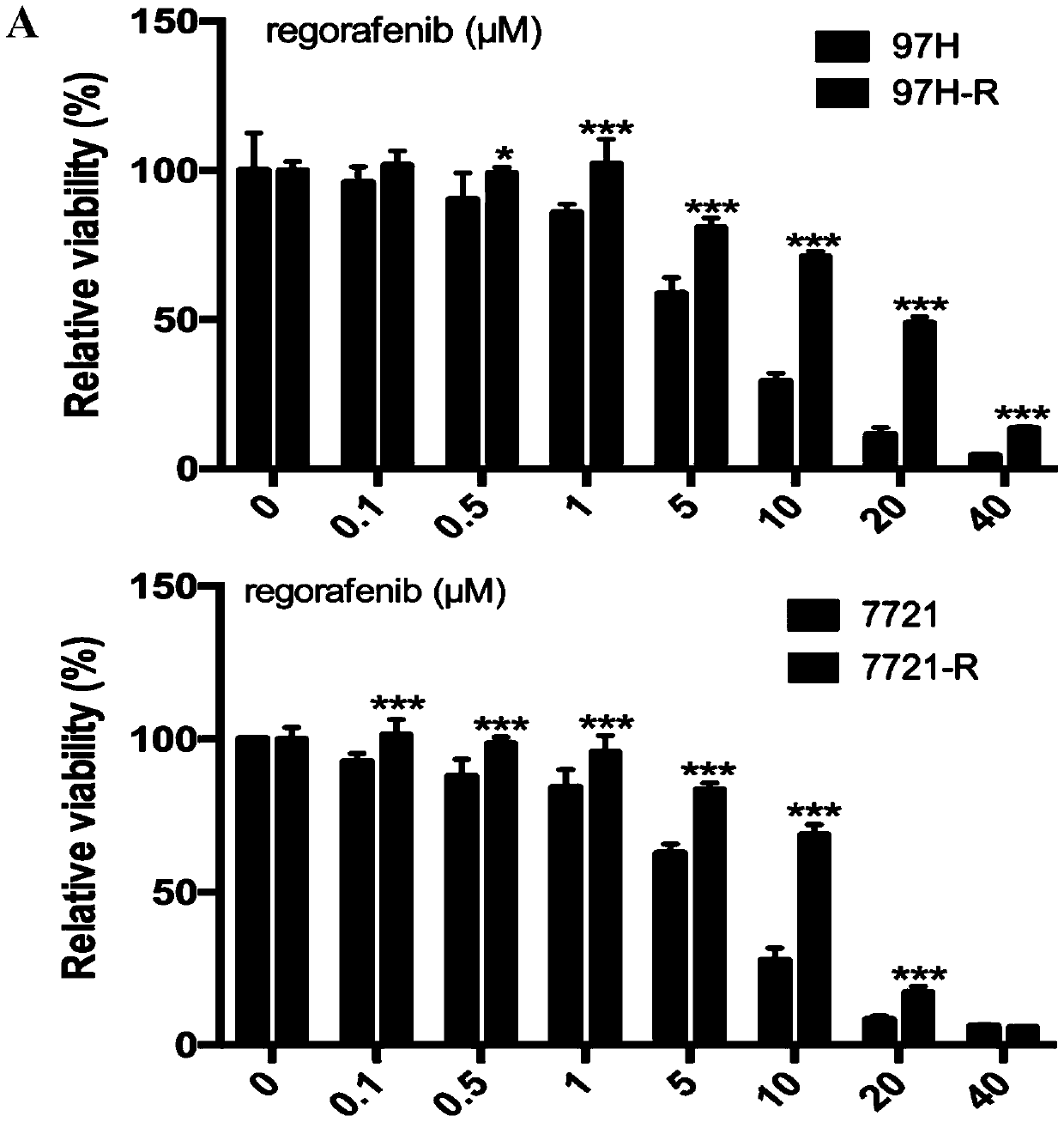Application of OPAGANIB in preparation of medicine for treating regorafenib-tolerant liver cancer
A technology for regorafenib resistance and treatment of liver cancer, which can be used in tumor therapy, especially in the field of reversal therapy of tumor resistance, and can solve problems such as unclear process and mechanism.
- Summary
- Abstract
- Description
- Claims
- Application Information
AI Technical Summary
Problems solved by technology
Method used
Image
Examples
Embodiment 1
[0042] Example 1 Successful Construction of Liver Cancer Regorafenib Acquired Drug-Resistant Cells
[0043] We detected the sensitivity of five strains of HCC cells BEL-7402, HuH-7, PLC / PRF / 5, SMMC-7721, and MHCC-97H to regorafenib by CCK-8 experiment, and calculated the corresponding Regorafenib IC 50 value. It can be found that the IC of regorafenib of SMMC-7721 and MHCC-97H 50 It was at a lower level in the five cell lines (Table 1), which proved that the two cell lines were relatively sensitive to regorafenib. Therefore, we selected these two lines of cells to construct regorafenib acquired drug-resistant HCC cell lines by increasing the concentration gradient method. After regorafenib continuously stimulated SMMC-7721 and MHCC-97H for six months, we tested the sensitivity of these two cell lines to regorafenib again and found that the IC of the two cell lines regorafenib 50 The value was significantly increased, and the drug resistance index RI was 3.133 (97H-R / 97H), ...
Embodiment 2
[0048] Example 2 The expression level of SphK2 is related to the acquired drug resistance of regorafenib
[0049] In order to verify whether SphKs is involved in the regulation of acquired drug resistance to regorafenib in HCC, we first compared the differences in the protein expression levels of SphK1 and SphK2 between drug-resistant cells and non-resistant maternal cells. The results of Western blot experiments showed that there was no significant difference in the expression of SphK1 protein between MHCC97H and 97H-R, SMMC-7721 and 7721-R, while the expression level of SphK2 was significantly increased in drug-resistant cells 97H-R and 7721-R ( figure 2 .A-B), indicating that SphK2, but not SphK1, may mediate acquired resistance to regorafenib in HCC. In addition, we also found that in five HCC cell lines BEL-7402, HuH-7, PLC / PRF / 5, SMMC-7721, and MHCC97H, the higher the gray value of the Western blot band of SphK2, the corresponding regorafenib IC 50 The value is also h...
Embodiment 3
[0050] Example 3 Overexpression of SphK2 reduces the sensitivity of HCC cells to regorafenib
[0051] In view of the fact that reducing the expression level of SphK2 protein can increase the sensitivity of drug-resistant cells to regorafenib, we further tested whether increasing the expression level of SphK2 protein can reduce the sensitivity of non-drug-resistant cells to regorafenib, and positively verified the role of SphK2 in Important role in acquired resistance to regorafenib in HCC.
[0052] We used lentiviral transfection technology to increase the protein expression level of SphK2 in non-drug-resistant HCC cells MHCC97H and SMMC-7721, and verified it by Western blot experiments. The results showed that the overexpression of SphK2 in non-drug-resistant HCC cells was successful ( image 3 .A). After stimulating HCC cells successfully overexpressing SphK2 and control HCC cells with different concentrations of regorafenib for 48 h, CCK-8 detection found that the viabilit...
PUM
 Login to View More
Login to View More Abstract
Description
Claims
Application Information
 Login to View More
Login to View More - R&D
- Intellectual Property
- Life Sciences
- Materials
- Tech Scout
- Unparalleled Data Quality
- Higher Quality Content
- 60% Fewer Hallucinations
Browse by: Latest US Patents, China's latest patents, Technical Efficacy Thesaurus, Application Domain, Technology Topic, Popular Technical Reports.
© 2025 PatSnap. All rights reserved.Legal|Privacy policy|Modern Slavery Act Transparency Statement|Sitemap|About US| Contact US: help@patsnap.com



